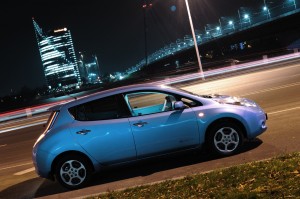Electric Vehicles: Myths, Reality, and Policy
 In this series of blog posts, RFF researchers Joshua Linn and Virginia D. McConnell take a look at the current state of the electric vehicles (EVs) and the effect of current and future policies on the market. Click to read the second, third, fourth, and fifth installments.
In this series of blog posts, RFF researchers Joshua Linn and Virginia D. McConnell take a look at the current state of the electric vehicles (EVs) and the effect of current and future policies on the market. Click to read the second, third, fourth, and fifth installments.
There have been numerous news articles and much hype about electric vehicles (EVs) over the last few years. Advocates believe they are the best option for dramatically reducing oil consumption and greenhouse gas emissions (GHGs) from light duty vehicles in the next 20 years. Governments at the federal and state levels have implemented large subsidies for electric vehicles to spur their introduction to the market—one goal is to have a million EVs on the road by 2015. Most of the subsidies were initiated under the Energy Independence and Security Act (EISA) in 2007, and have been extended and modified in recent years. The subsidies are designed to help jump start alternative engines and fuels, to both improve energy security and reduce greenhouse gas emissions that contribute to climate change.
Doubters see the subsidies as a waste of tax-payer money, and they see limited sales of electrics even with subsidies and other policies. And, media accounts tell conflicting stories about how well EVs are actually doing in the marketplace. Over the next few posts, we’ll try to take an unbiased look at the current state of the EV market, and at the effect of current and future policies.
First, it is important to define EVs. Electric vehicles get some or all of their power by plugging-in to the electricity grid. They include all-electric vehicles that get all of their power from an external charge, such as the Nissan Leaf; and, plug-in hybrid electric vehicles (often referred to as PHEVs) that have both a battery and a gasoline engine, such as the Chevy Volt and Prius Plug-In. A variety of new models of both types are being introduced to the market each year. Note that these EVs that plug in to the electricity grid are distinct from traditional hybrid-electric vehicles that do not plug in, like most models of the Toyota Prius.
About Virginia D. McConnell
Virginia McConnell is a senior fellow at Resources for the Future. Her research focuses on the effects of pricing and regulatory policies on environmental and economic outcomes, primarily in the areas of transportation and land use. McConnell is also a professor of economics at the University of Maryland, Baltimore County, and has recently served on a number of National Research Council Panels, including the Committees on Transitions to Alternative Vehicles and Fuels and the Fuel Economy of Light Duty Vehicles.
- Web |
- More Posts (11)
About Joshua Linn
Josh Linn’s research centers on the effect of environmental regulation and market incentives on technology, with particular focus on the electricity sector and markets for new vehicles. His work on the electricity sector has compared the effectiveness of cap and trade and alternative policy instruments in promoting new technology, including renewable electricity technologies.
- Web |
- More Posts (17)

 Subscribe; to our RSS Feed
Subscribe; to our RSS Feed Tweets by @RFF_org
Tweets by @RFF_org 